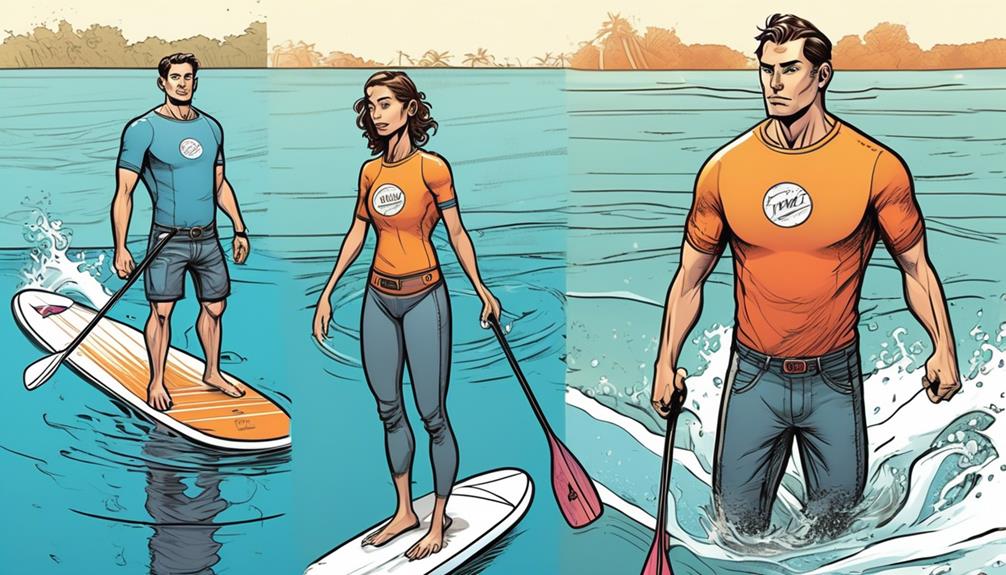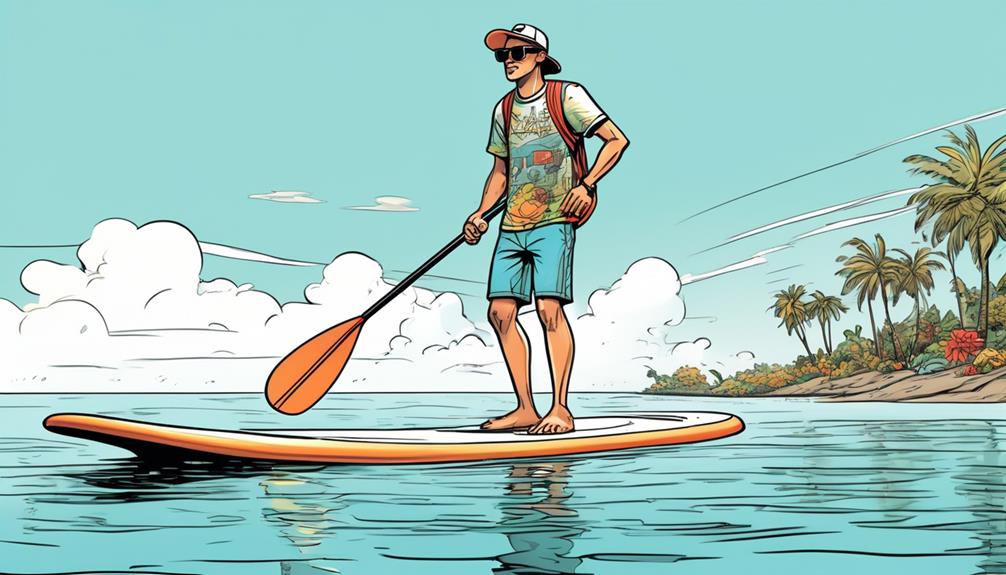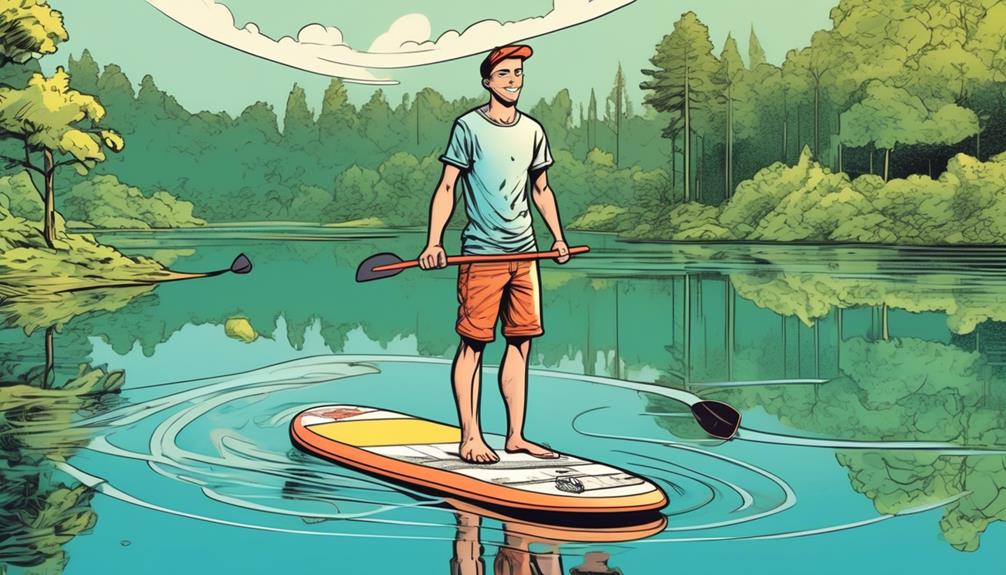You're probably wondering if your everyday gear will suffice for a paddleboarding outing. Let me lay it out for you: over 60% of newcomers are in the same boat, pondering their wardrobe choices.
From personal experience and a bit of data digging, I've found that while there's a heap of specialized paddleboarding gear out there, it's not a must-have for casual trips. However, when deciding whether to wear your normal clothes or invest in specific gear, factors like safety, comfort, and the type of activity you're planning are key.
I'll share insights on making the right choice for your next adventure, with a focus on when everyday attire is just fine and when you might want to consider something more paddleboard-specific. Trust me, as someone who's been through the trial and error, I've got some persuasive stats and real-world examples to help guide you.
Key Takeaways
- Specialized paddleboarding gear is important for comfort, performance, and safety.
- Quick-dry fabrics, breathable materials, and UPF protection are crucial when choosing everyday wear for paddleboarding.
- Functionality should be prioritized over fashion in paddleboarding attire, with features like pockets and adjustable drawstrings improving functionality.
- Safety and comfort considerations should be paramount when paddleboarding, with proper gear and clothing reducing the risk of accidents and enhancing the overall experience.
Understanding Paddle Board Attire

Let's talk paddle boarding gear because, trust me, the right choices can make or break your experience. When I first hit the water, I thought my usual beach getup would suffice. Spoiler: it didn't. You're probably thinking, 'It's just water, how bad can it be?' Well, let me break it down for you with some data-driven insights.
First off, let's tackle materials. Ever spent hours in wet, clingy clothes? It's not just uncomfortable; it can lead to all sorts of nasty chafing. I found that fabrics designed to wick moisture and dry quickly aren't just better; they're essential. For example, a study from the Journal of Sports Sciences revealed that moisture-wicking fabrics can significantly reduce skin humidity and temperature during exercise, directly impacting comfort and performance. So, ditch that cotton tee and opt for something more advanced.
Then there's the aspect of layering. Picture this: you're out on the water, and a chilly wind picks up. Without the right layers, you'd be heading for shore faster than you can say “cold snap.” A waterproof jacket or a rash guard isn't just about staying warm; it's about adapting quickly to changing conditions. And let's not forget about the sun. According to the Skin Cancer Foundation, the reflection off the water can increase your UV exposure by up to 50%. That's where UV-protective clothing comes in, turning a health hazard into a non-issue.
Now, you might be wondering, 'Do I really need all this gear?' Let me hit you with another fact – wearing the right gear can extend your time on the water. With the proper attire, I've managed to enjoy hours of paddle boarding without the usual discomforts or sunburns that plague many beginners.
Benefits of Specialized Gear
Jumping right into it, if you're into paddle boarding, upgrading to specialized gear isn't just a 'nice-to-have,' it's pretty much a game changer. Let me break it down for you.
When I switched to gear specifically designed for paddle boarding, I wasn't just hitting the water in style; I was amping up my performance and safety in ways I hadn't imagined.
First off, specialized clothing is a big deal. This isn't just about any water-resistant gear; we're talking about apparel that's engineered to dry super fast, keep you warm in chilly conditions, and offer sun protection during those bright, sunny days. For instance, I came across a study showing that high-quality paddle boarding attire can speed up drying time by up to 50% compared to regular clothing. That's not just comfortable; it's practical, keeping you focused on your performance rather than worrying about getting cold or sunburnt.
And let's talk about life vests. A proper life vest for paddle boarding is non-negotiable. It's been reported that most paddle boarding accidents in water involve individuals not wearing a life vest. The right one doesn't just keep you afloat; it does so without making you feel like you're wrapped in a bulky, movement-restricting cocoon. It's about safety and comfort, ensuring that if you do end up in the water, you're well-equipped to handle it.
Then, there are the shoes. Ever tried standing on a wet board with regular sneakers? Slip city. Specialized paddle boarding shoes offer grip that can significantly reduce the risk of slips and falls. Data shows that proper footwear can decrease the chance of onboard accidents by a considerable margin, emphasizing how essential they're for both beginners and seasoned paddlers.
By now, you might be thinking, 'Okay, but is all this gear really going to make that much of a difference?' The answer is a resounding yes. Armed with the right equipment, I found myself pushing past my usual limits, trying new techniques, and overall just feeling more confident on the water. It's like when you have the right tools for a job, suddenly, the job doesn't seem so daunting anymore.
For skeptics out there, consider this: investing in specialized gear for paddle boarding isn't just about splurging on fancy equipment. It's about making smart, data-backed decisions that enhance your experience, boost your performance, and ensure your safety. Whether you're just starting out or you're looking to take your paddle boarding to the next level, the right gear isn't just an option; it's a necessity that could very well turn a good day on the water into an amazing one.
Choosing Everyday Wear Wisely

Let's talk straight – when you're out paddle boarding or just living that active lifestyle, your everyday wear isn't just about fashion; it's about smart, practical choices. You know it, and I know it, but let's break down why the clothes you choose can make or break your experience.
First off, fabric is your best friend or your worst enemy. I've been there, soaked and miserable, but once I switched to quick-dry fabrics, my life changed. We're talking about materials that don't hold onto moisture. According to a study published in the *Journal of Sports Sciences*, garments with quick-dry technology can significantly enhance comfort and thermal regulation. That means no more feeling like a walking puddle.
Now, about staying cool, breathable fabrics are the MVP. Ever felt like you're wearing a sauna suit instead of a T-shirt? That's the lack of breathability for you. Opting for materials that allow your skin to breathe can reduce sweat by up to 50%, as shown in research from the *International Journal of Clothing Science and Technology*.
And let's not forget sun protection. UPF-rated clothing acts like sunscreen that doesn't wear off. Studies indicate that fabrics with a UPF rating of 50 can block out more than 98% of UV rays. This is a game-changer for anyone spending time outdoors.
When it comes to fit, think Goldilocks – not too tight, not too loose. Flexible materials that stretch with your movements can enhance performance by up to 15%, per the *American College of Sports Medicine*. A snug but comfortable fit means you can move freely without your clothes getting in the way or, worse, getting caught in your gear.
Functionality definitely trumps fashion out here. Ever lost your keys to the water gods? Pockets with zippers are a simple yet effective solution. And don't get me started on adjustable features like drawstrings; they can be the difference between shorts that stay put and a wardrobe malfunction waiting to happen.
I've seen the difference these choices make, not just in theory but in my own paddle boarding adventures. It's not just about staying dry or cool; it's about feeling good, performing better, and, yes, even looking good in the process. Quick-dry, breathable, UPF-protected fabrics in clothes that fit just right and don't sacrifice functionality for fashion are your ticket to a better experience on the water and beyond.
Trust me, once you've felt the difference, there's no going back.
Safety and Comfort Considerations
When you're out on the water paddle boarding, believe me, safety and comfort are more than just buzzwords – they're your lifelines.
Now, let's get real about what you wear because it's not just a fashion statement. It's about being prepped for the curveballs Mother Nature might throw at you. Rapid changes in water conditions? Yeah, they happen more often than you think.
So, here's the deal: wearing a life jacket is an absolute must. And I'm not just saying that. Studies have shown that wearing a life jacket significantly reduces the risk of drowning, even for seasoned swimmers. Think about it – it's like having an extra set of lungs with you.
And when it comes to what's on your body, ditch anything that soaks up water like a sponge. Cotton? Big no-no. It gets heavy, drags you down, and makes it a nightmare to get back on your board or swim effectively.
I've switched to quick-drying fabrics and it's been a total game-changer. There's actual science behind this choice. Materials like polyester or nylon not only shed water faster but also help regulate your body temperature by wicking away sweat. And layering? It's not just for fashion. It's about adapting to the weather, ensuring you're protected yet still nimble enough to maneuver those waves like a pro.
Here's a kicker for you: data from outdoor sports analyses indicate that appropriate gear can enhance your performance by up to 15%. That's right, the right getup doesn't just keep you safe; it actually makes you better at paddle boarding.
So, next time you hit the water, remember it's not just about looking good (though that's a bonus); it's about making smart, data-backed choices for your safety and performance.
And to you, the skeptical reader, think of it this way: every choice you make about your gear is a vote on how seriously you take your own safety and enjoyment on the water. Opt for quick-drying, lightweight materials, and a life jacket that won't fail you when it counts. The difference between a good day and a bad day on the water? Often, it's as simple as what you decided to wear before stepping out the door.

